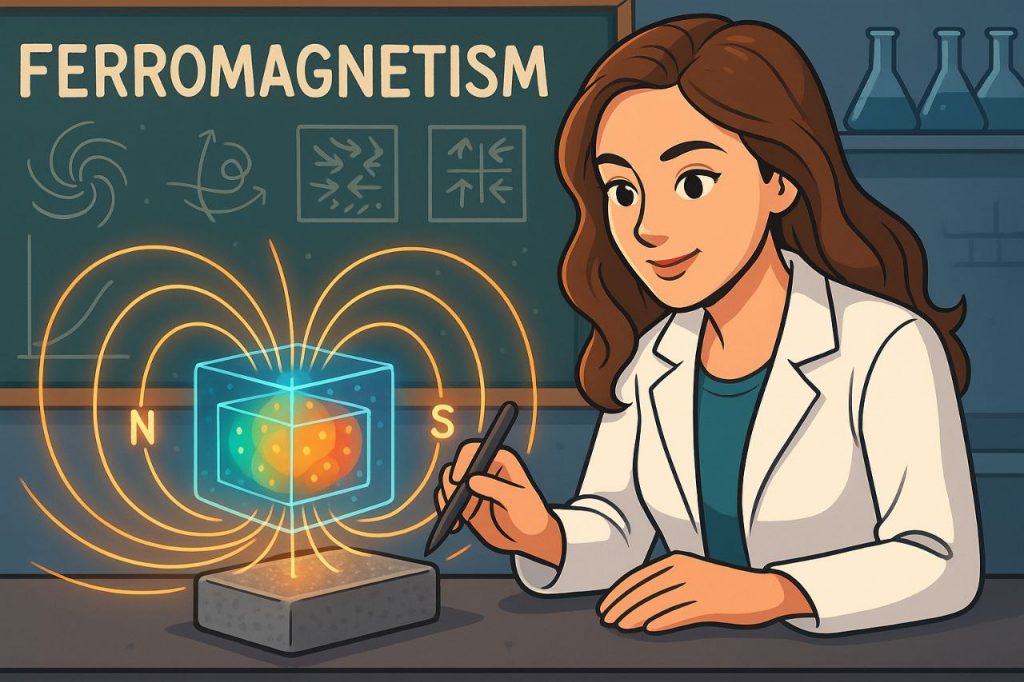Ferromagnetism is one of the most fascinating and practical phenomena in physics. It is the fundamental principle behind magnets, electric motors, data storage, and many everyday technologies. From refrigerator magnets to MRI machines and hard drives, ferromagnetism plays a central role in modern life. But what exactly is it, and why do certain materials exhibit this remarkable property while others do not? Understanding ferromagnetism reveals not just the science of attraction but also the invisible quantum order that shapes our technological world.
What Is Ferromagnetism?
Ferromagnetism is the physical property that allows materials such as iron, nickel, and cobalt to become magnets or be attracted to magnets. This occurs because the tiny magnetic moments of individual atoms — caused by the spin of their electrons — align in the same direction. When many atoms align, their magnetic fields combine, producing a strong, unified magnetic field. This collective alignment distinguishes ferromagnetic materials from others, like paramagnetic or diamagnetic substances, in which atomic magnetic moments are random or oppositely aligned.
The Quantum Nature of Magnetism
At the atomic level, magnetism originates from electron spin, a quantum property that gives each electron a tiny magnetic moment. In most materials, these spins cancel out, but in ferromagnetic materials, exchange interaction — a quantum mechanical effect — causes neighboring spins to align parallel. This alignment minimizes the system’s energy, leading to spontaneous magnetization even without an external magnetic field. Physicist Werner Heisenberg first described this phenomenon in the 1920s, explaining how quantum mechanics governs magnetic behavior. The result is a domain structure, where regions called magnetic domains each have uniform spin alignment.
Magnetic Domains and Hysteresis
A fascinating feature of ferromagnetism is how magnetic domains respond to external forces. In an unmagnetized piece of iron, domains are oriented randomly, canceling each other’s effects. When an external magnetic field is applied, domains realign in the same direction, strengthening the material’s magnetic field. Even after the external field is removed, many domains remain aligned, resulting in remanent magnetization — this is what makes permanent magnets possible. However, reversing the magnetic field requires energy to overcome domain resistance, a process known as hysteresis. This property is essential in magnetic memory and data storage devices.
Temperature and the Curie Point
Ferromagnetism is sensitive to temperature. When heated beyond a specific threshold known as the Curie temperature, ferromagnetic materials lose their ordered alignment and become paramagnetic — weakly attracted to magnetic fields. For example, the Curie temperature of iron is about 770°C (1,418°F). Above this point, thermal energy disrupts the spin alignment, breaking the collective magnetic order. The concept, introduced by Pierre Curie in the late 19th century, remains crucial for understanding magnetic transitions and designing high-performance materials that can withstand extreme conditions.
Applications of Ferromagnetism in Technology
Ferromagnetism has shaped nearly every modern technology involving electricity and data. It enables the operation of electric motors, transformers, and generators, converting electrical energy into motion and vice versa. In computing, hard disk drives and magnetic tapes rely on tiny ferromagnetic regions that store binary data through controlled magnetization. Electromagnets, created by passing current through ferromagnetic cores, are used in cranes, medical devices, and particle accelerators. MRI machines utilize strong ferromagnetic materials to generate stable magnetic fields that allow for detailed imaging of the human body.
Advanced Materials and Magnetic Alloys
Modern research focuses on improving ferromagnetic materials for energy efficiency and advanced electronics. Alloys like Alnico (aluminum-nickel-cobalt) and NdFeB (neodymium-iron-boron) have revolutionized permanent magnet design, offering higher strength and thermal stability. Scientists are also studying ferromagnetic semiconductors that combine magnetic and electronic properties for use in spintronics — a new field where data is stored and processed using electron spin rather than charge. These materials could lead to faster, more energy-efficient computers and next-generation quantum devices.
Ferromagnetism in Nature and Beyond
Ferromagnetism is not just a human-made phenomenon — it occurs naturally in some minerals like magnetite (Fe₃O₄), which was used by ancient civilizations for navigation. The Earth’s own magnetic field originates from a dynamo effect in its liquid iron core, a large-scale version of ferromagnetic principles at work. Magnetotactic bacteria even use chains of magnetic crystals to orient themselves along geomagnetic lines, showing that magnetism influences life on a microscopic scale.
Expert Insights
According to Dr. Laura Henderson, a materials physicist at Cambridge University, “Ferromagnetism is the perfect example of how order emerges from chaos — atomic spins aligning in harmony to create one of the most powerful forces in physics.” Meanwhile, Professor Kenji Sato, a leading researcher in spintronics, emphasizes that “understanding spin alignment at the nanoscale is key to developing faster and more sustainable digital technologies.” Experts agree that studying ferromagnetism is not just about understanding magnets, but about exploring the quantum foundation of energy and matter.
The Future of Ferromagnetic Research
The next frontier in ferromagnetism involves quantum materials, nanomagnetism, and magnetic metamaterials that manipulate light and electromagnetic waves. Scientists are developing ultra-thin magnetic films only a few atoms thick, capable of switching magnetization with electric fields instead of magnetic ones — a breakthrough for low-power memory devices. Ferromagnetic materials are also being integrated into fusion reactors and space exploration technologies, where precise magnetic control is vital. The deeper our understanding grows, the more applications will emerge from this ancient yet ever-modern force.
Interesting Facts
- The word ferromagnetism comes from the Latin ferrum, meaning “iron.”
- The strongest permanent magnets today are made of neodymium, capable of lifting objects over 1,000 times their own weight.
- Ancient Greeks discovered magnetite more than 2,000 years ago.
- A single refrigerator magnet contains millions of aligned atomic domains.
- The Earth’s magnetic field reverses polarity approximately every 300,000 years due to core dynamics.
Glossary
- Electron Spin – A quantum property of electrons that gives rise to magnetism.
- Magnetic Domain – A region within a material where atomic spins are aligned in the same direction.
- Exchange Interaction – The quantum mechanical effect that causes neighboring spins to align.
- Hysteresis – The lag between changes in a magnetic field and the magnetization of a material.
- Curie Temperature – The temperature above which a ferromagnetic material becomes paramagnetic.
- Spintronics – A field of technology that uses electron spin to process and store information.
- Paramagnetism – Weak attraction to magnetic fields due to unaligned spins.
- Magnetite – A naturally occurring ferromagnetic mineral.
- NdFeB Magnet – A high-strength alloy magnet composed of neodymium, iron, and boron.
- Metamaterial – An engineered structure with properties not found in natural materials.


